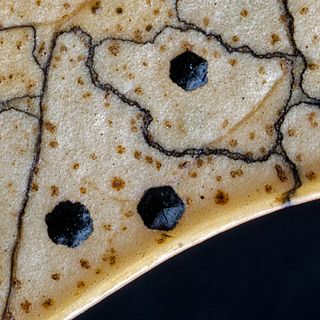
Triplophysa is a genus of fish in the family Nemacheilidae found mainly in and around the Qinghai-Tibet Plateau in China, as well as inland waters of the larger part of central Asia. They can be distinguished from other genera of Nemacheilidae by marked sexual dimorphism, including the development of nuptial tubercles on breeding males. Currently, the genus is a mixed assemblage of species. Some lineages have been identified and treated as subgenera, but as Wikipedia follows Fishbase for fish species all but Hedinichthys have been treated as subgenera in Wikipedia, although Kottelat in his revision of the loaches did recognise them as valid. FishBase, however, includes these in Triplophysa without specifying subgenera and treats the names given by Kottelat as synonyms.

Phanerochaete is a genus of crust fungi in the family Phanerochaetaceae.

Myelochroa is a genus of foliose lichens in the family Parmeliaceae. They are commonly known as axil-bristle lichens. It was created in 1987 to contain species formerly placed in genus Parmelina that had a yellow-orange medulla due to the presence of secalonic acids. Characteristics of the genus include tightly attached thalli with narrow lobes, cilia on the axils, and a rhizinate black lower surface. Chemical characteristics are the production of zeorin and related triterpenoids in the medulla. Myelochroa contains about 30 species, most of which grow on bark. The genus has centres of distribution in Asia and North America.

Bulbothrix is a genus of lichen-forming fungi in the family Parmeliaceae. This genus is synonymous with Bulbothricella V.Marcano, S.Mohali & A.Morales. Bulbothrix was circumscribed by lichenologist Mason E. Hale in 1974 with Bulbothrix semilunata as the type species.

Ceriporia is a widely distributed genus of crust fungi.

Coccomyces is a genus of fungi in the family Rhytismataceae.

Skeletocutis is a genus of about 40 species of poroid fungi in the family Polyporaceae. The genus has a cosmopolitan distribution, although most species are found in the Northern Hemisphere. It causes a white rot in a diverse array of woody substrates, and the fruit bodies grow as a crust on the surface of the decaying wood. Sometimes the edges of the crust are turned outward to form rudimentary bracket-like caps.

Septobasidium is a fungal genus within the family Septobasidiaceae. Approximately 175 described species are associated with this genus. 227 records are listed by Species Fungorum.

Polyporus umbellatus is an edible species of mushroom, found growing on roots of old beeches or oak (e.g.). It is also called umbrella polypore.
Morchella bicostata is a species of fungus in the family Morchellaceae. It is found in southwestern China.
Leohumicola incrustata is a species of fungus. It was named after the appearance of its terminal conidial cells, incrusted with a crust-like slime. It was first found in the Cape of Good Hope Nature Reserve, from heated soil. Large warts or the production of slime on its terminal cell are this species' defining characteristics. Its conidia are similar to those of L. verrucosa, however in the latter the wall ornamentation forms smaller warts.
Septobasidium polygoni is a plant pathogenic fungus in the genus Septobasidium. It was first isolated from Koenigia campanulata.
Septobasidium gaoligongense is a plant pathogenic fungus in the genus Septobasidium. It was first isolated from Eurya groffii.
Neosporidesmium xanthophylli is a species of anamorphic ascomycete fungi, first found in tropical forests in Hainan, China, specifically in dead branches of Xanthophyllum hainanense, hence its name.
Neosporidesmium malloti is a species of anamorphic ascomycete fungi, first found in tropical forests in Hainan, China, specifically in dead branches of Mallotus hookerianus, hence its name.
Leptonetela is a genus of leptonetids that was first described by J. Kratochvíl in 1978.

Nanhaipotamon is a genus of freshwater crabs, in the subfamily Potamiscinae, found in southern China and Taiwan. As of 2018, 18 species have been described. The genus is named after the South China Sea, for it occurs mostly in coastal areas. The genus was first described by R. Bott in 1968 as Isolapotamon (Nanhaipotamon), i.e., a subgenus of Isolapotamon.
Helicia nilagirica is a tree of the Proteaceae family. It grows from Thailand across Mainland Southeast Asia to Yunnan, Zhōngguó/China and over to Nepal. It is a source of wood, a pioneer reafforestation taxa, and an ethnomedicinal plant.
The Septobasidiales are an order of rust fungi in the class Pucciniomycetes. It contains the single family Septobasidiaceae, which itself comprises six genera: AphelariopsisJülich, AuriculoscyphaD.A. Reid & Manim., CoccidiodictyonOberw., JohncouchiaS. Hughes & Cavalc., SeptobasidiumPat. and lastly, UredinellaCouch.









